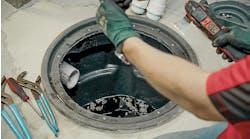In the Oct. 6, 2006, Federal Register, the U.S. Department of Energy (DOE) published a proposed rule to amend the federal minimum efficiency standards for residential furnaces and boilers. Though the 59-page document is sometimes unclear and incomplete, it is slated to go into effect in September 2012, less than a year from now. When I surveyed three smart plumbers and three astute manufacturer's reps, none had heard of it.
But all were aware of changes that have been happening in boiler efficiency and the addition of features such as outdoor reset. The fact is that modulating boilers have mostly conformed to the legislation. Non-modulating (single-fire boilers) manufacturers are planning to meet the requirements. The fact is that boilers manufactured after Sept. 2012 are going to be different. The burner may or may not run upon a call for heat. Boilers may or may not maintain water temperature at the plumber’s preferred set point. The goal is to try to either reduce off-cycle losses or meet the demand using residual heat in the boiler before bringing on the burner. These are good things for homeowners watching their energy expenditures. But they can be a source of confusion and problems for plumbers who don't understand the changes or the thinking behind them.
Here is an explanation of the coming changes according to Rich Simons, director of the Residential Burner Boiler Business at Honeywell.
• There will be no standing pilots in boilers manufactured after Sept. 2012.
• There must be an automatic means for adjusting water temperature based on the demand load for gas, oil and electric modulating hot water boilers. An exception is made for boilers equipped with tankless domestic water heating coils. There is also an exception for boilers that use no electricity.
• The automatic means must decrease boiler water temperature when the load is decreasing, and it must increase the water temperature when the load is increasing. One way to do this is outdoor reset, decrease the water temperature when weather is warmer, and increase water temperature when it is colder outside.
• Other methods are possible, for example inferential load. Several manufacturers use this in software to predict the optimum set point.
• Requirements for modulating boilers have already been adopted for the most part. Almost all modulating boilers have the capability for outdoor reset. But they will have to indicate when the outdoor reset is not functioning, and perhaps when outdoor temperature sensors are not installed.
• Non-modulating (also called single input rate) boilers may meet requirements using the above technologies. Or they may use another option called thermal purge. Thermal purge means that instead of changing water temperature based on demand, the system uses residual heat in the system to satisfy a call for heat before allowing the burner to come on. Upon a call for heat, the circulator comes on to move already-heated water. If that does not satisfy the call for heat within a limited amount of time, then the burner comes on. An important situation to recognize is that a call for heat could be satisfied with residual heat alone, without the burner coming on.
Manufacturers may develop other ways to delay the operation of the burner, so long as a greater calculated residual heat results in a greater delay of the burner. The manufacturer must document how the automatic means identifies the amount of residual heat available.
• A requirement for all boilers is that when there is no inferred heat load (i.e. it is too warm outside to need heat), the boiler water temperature is automatically maintained at not more than 140º F.
• A boiler must be inoperable if the automatic means for adjusting water temperature is not installed. However modifications are in the works to provide that:
- If the automatic means becomes inoperable, the system will indicate a fault, but will allow the boiler to function.
- If there is an external energy management system that reduces boiler water temperature.
- If the boiler is not used for any space heating, for example snowmelt.
- If the boiler is part of a modular or multiple boiler system having a total input of 300,000 BTU/hour or greater.
- If the boiler is equipped with a tankless coil, as in domestic hot water.
Terminology used
Here are some clarifications of terminology used around the legislation:
Heat load is the amount of heat that is needed to satisfy the thermostat.
Inferred heat load is a predicted amount of heat needed to satisfy the thermostat. In warmer weather it is less than in colder weather.
Incremental change in inferred heat load must produce a corresponding incremental change in the boiler water temperature. This means that as the predicted demand for heat decreases, the boiler water temperature is decreased.
Outdoor reset or outdoor temperature compensation is an obvious way to get the automatic water temperature change. But there are other possibilities (see above.) If the outdoor rest is not functioning, the boiler must either limit the set point to 140°F or indicate that there is a problem.
Implications
Before you get all worked up, keep in mind that these implications apply only to boilers manufactured after Sept. 2012. So, no, you don’t have to go and retrofit anything. (However, retrofitting outdoor reset would be a good thing to offer homeowners to save money.)
There will be no more electromechanical controls on new boilers. Instead, the controls will be all electronic. The old familiar L8148 will not be on new boilers, but will remain available as a service part.
The most important implication is that the plumber is going to have even less control over boiler water temperature. This is good for the homeowner’s pocketbook. For the plumber, whether or not he welcomes the changes, the best thing he can do is learn how the new technologies work, so he can continue to be in control of his work!
Carol Fey is a degreed technical trainer who has worked as a heating technician in Antarctica. She has published five books especially for the HVAC industry. Her website is: www.carolfey.com.

